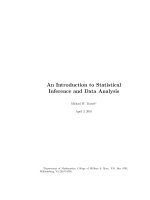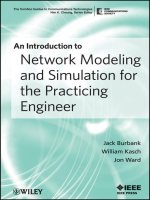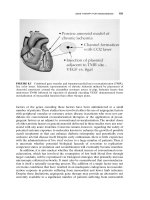An Introduction to Washing Principles and Products
Bạn đang xem bản rút gọn của tài liệu. Xem và tải ngay bản đầy đủ của tài liệu tại đây (2.93 MB, 80 trang )
Introduction to Denim Laundry Principles
RBD Garment Team
10/06
An Introduction to
Washing Principles and
Products
Introduction to Denim Laundry Principles
RBD Garment Team
10/06
Mechanism differences
vertical
We have to be carefull about 3 main parameters at
laundry machines. These 3 parameters are;
1-rotation speed of the machine
2-falling height (depends on loading capacity, water
amount, wing structure and rotation speed)
3-Machine surface area and structure (depends on the
type of machine (vertical or horizontal) and amounts and
size of the holes at the surface of machine)
For the best results during the rotation of the machine
from left to right, wings of the machine has to throw the
garments from hour 11 point to hour 5 point. This
adjustment can be done by arranging the loading amount-
water level-and rotation speed. This equilibrium is the
best level for optimum effect and safe wash. If the falling
point passes over 12 then abrasion will be lost, if the
falling point occurs before or around 9 again abrasion will
be lost and in both cases related to the structure of the
fabric risk of crease increases too much.
Introduction to Denim Laundry Principles
RBD Garment Team
10/06
Mechanism differences
ROTATION SPEED
LIQOUR RATIO
RELATION
LOW LIQOUR
RATIO
MEDIUM LIQOUR
RATIO
HIGH LIQOUR
RATIO
LOW ROTATION
SPEED
RISKY WASHING ONLY POSSIBILITY
BY REDUSING THE
LOADING
CAPACITY
OPTIMUM
WASHING POINT 2
MEDIUM ROTATION
SPEED
ONLY POSSIBILITY
BY REDUSING THE
LOADING
CAPACITY
ONLY POSSIBILITY
BY REDUSING THE
LOADING
CAPACITY
ONLY POSSIBILITY
BY REDUSING THE
LOADING
CAPACITY
HIGH ROTATION
SPEED
OPTIMUM
WASHING 1
ONLY POSSIBILITY
BY REDUSING THE
LOADING
CAPACITY
RISKY WASHING
Introduction to Denim Laundry Principles
RBD Garment Team
10/06
WASHING MACHINERY
Vertical Drum
-sophisticated
-high degree of automation / control
-various sizes up to 750 kg capacity
-more common in Europe/ North Africa/ Americas
BARREL
-simple
-lower degree of sophistication
-more aggressive action
-more common in Asia
Introduction to Denim Laundry Principles
RBD Garment Team
10/06
Mechanism differences
vertical barrel
Drum diameters are different,
beating rate per turn higher.
Introduction to Denim Laundry Principles
RBD Garment Team
10/06
Mechanism differences
vertical
barrel
For machines of equal capacity, the barrel
machine has greater metal surface friction area.
Introduction to Denim Laundry Principles
RBD Garment Team
10/06
Mechanism differences
Carriage
time
Fall
time
Introduction to Denim Laundry Principles
RBD Garment Team
10/06
Mechanism differences
vertical
barrel
Introduction to Denim Laundry Principles
RBD Garment Team
10/06
Mechanism differences
for vertical drum machine
less friction is imparted,
resulting in less abrasion.
vertical
barrel
Introduction to Denim Laundry Principles
RBD Garment Team
10/06
-Pre-treatment
-stone and/or enzyme wash
effect adjustment
-bleaching
colour adjustment
-finishing
Handle adjustment
Main procsess in the laundry
Introduction to Denim Laundry Principles
RBD Garment Team
10/06
BASIC DENIM WASHING PRINCIPLES
z -Pre-treatment
z This step is the basic, but most important part of washing. Related to the final target we have to take the correct prevention in this
part. This process has 3 main targets; removing the impurities coming from the fabric, de-sizing at weaving fabrics and
decreasing the crease risk on the garment
*removing the impurities:
-either from the cotton or from the manufacturing period garment can contain some impureties. These impurities can be
based on oil, alkaline or acidic chemicals and all of them can cause several problems in the next steps of washing. In this step a
professional laundry man has to decide about the risk and he has to use the suitable auxiliaries to remove these impurities.
*de-sizing:
-all of the weaved fabrics contains size on them. During the weaving processes there can be two main problems;
one is breaking of the yarn because of high friction and second is dust formation. Size is the solution of these problems, because
sizes are making a floppy film on surface and improves the tensile strength and directly causes better efficiency. However, this
size becomes a problem so it must be remove in washing. There are several types of size are available in the market. But they can
divided in two groups-water soluble sizes (CMC or PVA based sizes) and dissolvable sizes in water (starch based sizes)-
Starch based sizes still are used widely and have the biggest market share because of their cheap prices and easy purchase
conditions.There are 4 methods to remove the size;
1-washing with high alcalines
2-washing with high acids
3-washing with oxidative chemicals
4
-enzymatic desizng with alfa-amylases
z First three methods are difficult , risky and expensive method at laundry business because of this nearly all of the market prefers enzymatic
de-sizing.
Introduction to Denim Laundry Principles
RBD Garment Team
10/06
BASIC DENIM WASHING PRINCIPLES
z Preventation of creases: One of the main problems in laundry
business is creases. We can separate creases into 4 groups
related to their reasons;
z Mechanic based creases:
these are the creases related to the ratio of water,
loading capacity and rotation speed of drum.
z Chemical reaction based creases:
These are the creases related to the wetting time of fabric
or unevenness auxiliary applications
z Fabric based creases:
These are the creases comes from the production of the
fabric
z Storage based creases
Introduction to Denim Laundry Principles
RBD Garment Team
10/06
BASIC DENIM WASHING PRINCIPLES
z DESİZİNG RECİPE
LİQOUR RATIO: 1/6-1/10 (DEPENDİNG ON MACHİNE TYPE)
TIME : 10 MİNUTES
LAVA ZYME DEZ 0,5-1 GR/LT(
amylase enzyme for removing of size)
LAVA WET W-LA 0,5-1 GR/LT(wetting and scouring agent)
LAVA SPERSE KDS 0,5-1 GR/LT(dispersing and washing agent)
SERA LUPE M-CF 0,5-1 GR/LT(anti-crease agent)
Introduction to Denim Laundry Principles
RBD Garment Team
10/06
WETTING DISPERSING AGENT
z Used in Desizing process
must rapidly wet out jean
prevents white lines caused by rigid creases
permits penetration of Amylase to fully desize
prevents back staining of loose indigo onto weft yarns and
pockets
z Also used in stonewash / after washing to reduce back staining
Introduction to Denim Laundry Principles
RBD Garment Team
10/06
BACK-STAINING
z Re-deposition of loose indigo, or indigo dyed short fibres, removed during
desizing, stone-washing or enzyme washing.
z Re-deposited Indigo, reduces the contrast between warp and undyed weft
z Re-deposited indigo stains pockets and labels
z Re-deposited indigo is more prone to Ozone and yellowing
AND SOLUTION LAVA SPERSE GROUPS
z Back-staining is UNDESIREABLE in denim washing
Introduction to Denim Laundry Principles
RBD Garment Team
10/06
BACK-STAINING
z THERE ARE 3 BASIC GROUPS OF DISPERSING AGENTS
z FIRST GROUP IS WASHING AND SCOURING BASED PRODUCTS LIKE
LAVA SPERSE HOC
z SECOND GROUP IS DISPERSING ABILITY BASED PRODUCTS LIKE
LAVA SPERSE HES
AND THE THIRD AND MOST EFFECTIVE GROUP IS THE MIXTURE OF THESE TWO
GROUPS
LAVA SPERSE KDS
Introduction to Denim Laundry Principles
RBD Garment Team
10/06
ANTI-CREASE (Lava Lupe M-CF)
z Prevents crease formation during the washing procsess.
z Increases the loading capacity of the washing machine
z Reduses the stone spots risk during the stone wash procsess
Introduction to Denim Laundry Principles
RBD Garment Team
10/06
BASIC DENIM WASHING PRINCIPLES
Enzyme is a kind of protein, that is obtained by extraction method from naturally existing bacteria and
fungi. The structure of enzyme is a biologic polymer and it can be found every cell. Enzymes help
the chemical reactions in living cells by breaking the large molecules to smaller ones or vice versa.
z In fact, all the reactions can occur without enzymes, however enzymes reduce the energy demand
of the cell for initiating the reaction and increase its speed. So ,they are known as “ biological
catalyst “
z The starting molecule in a reaction is called “substrate” , and the yield molecule is called “substate”.
Enzymes , incorporate the reaction for yielding the “substate” but they may be recovered unchanged
at the end of the reaction. Therefore , the reaction can continue over and over again while the
enzyme is active .
z The relationship between the enzyme and substrate can be explained like lock-key model. So there
is only one substrate that the enzyme is active on. For instance , catalase enzymes decompose
hydrogen peroxide but they don`t affect the cellulasic fibres and cellulase enzymes attack the
cellulosic fibre and give no damage to the peroxides.
Introduction to Denim Laundry Principles
RBD Garment Team
10/06
Enzymes
Enzymes are living organisms
which will attack a specific molecular group
Their shape guarantees selectivity-
they are specific in their action
Anchor
Body
Head
Introduction to Denim Laundry Principles
RBD Garment Team
10/06
The advantages of using a product which contains enzymes versus
conventional chemical catalysts are as follows:
• Increase the rate of the chemical reactions,
• Provide mild conditions for reactions such as neutral pH and room temperature.
• The reaction can be easly controlled.
• Enzymes are biologically degredable , so they do not cause any environment
problems.
• They can be used instead of most of the harmful chemicals.
Introduction to Denim Laundry Principles
RBD Garment Team
10/06
Enzymes in Laundry Business
Amylase desizing (removes starch)
Laccase bio-bleaching
Catalase anti-peroxide
Cellulase breaks and removes fibres
Introduction to Denim Laundry Principles
RBD Garment Team
10/06
AMYLASES
z IF YOU THINK ALFA AMYLASES
AS KEY THEIR LOCK IS
STARCH. THEY CHANGE THE
FORM OF STARCH TO A WATER
SOLUABLE STRUCTURE
z THE MAIN DIFFERENCE AT
ALFA AMYLASES IS
TEMPARATURE STABILITY. SO
WE CAN CLASSIFY ALFA
AMYLASES AS TERMO-STABIL
AND NON-TERMO STABIL
GROUPS
Introduction to Denim Laundry Principles
RBD Garment Team
10/06
AMYLASES
z Lava® Zyme DEZ
effective 40 – 80 ºC
liquid - pumpable
z Lava® Zyme A-EN
1.5 times stronger than DEZ
liquid - pumpable
effective 40 – 95 ºC
z Normal desizing conducted at 70 ºC
z Higher temperature, more back staining of indigo onto pockets and white weft yarns, which is
undesirable
z Good alkaline stability
z can use products at lower temperature 55 ºC
reduces back staining
55 ºC – lower efficiency of enzyme – slightly higher dosage needed
Introduction to Denim Laundry Principles
RBD Garment Team
10/06
CELLULASE ENZYMES
z Here we use cellulase enzymes
which attack and weaken cellulose
(cotton)
z Enzymes weaken the surface fibres,
which are then mechanically torn off
during processing taking with them
indigo.
z The need mechanical action to work,
often to improve the rate of abrasion
they are used with stones.
attack
point
Introduction to Denim Laundry Principles
RBD Garment Team
10/06
Indigo dyeing mechanism
Consider a textile yarn.
It is not just a smooth
surface, but thousands of
parallel fibres twisted
together. The surface is not
smooth, it had fibre ends
poking out.









